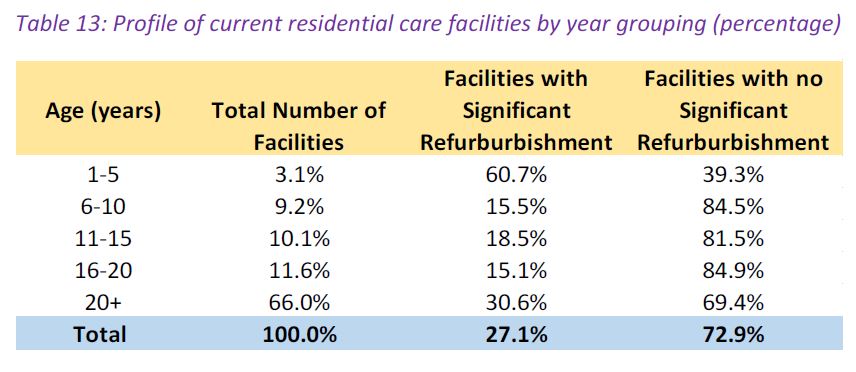The StewartBrown Senate submission identifies that in the 2015-16 financial year there was an estimated $4.5 billion of capital spending on residential aged care projects, principally funded by for-profit and not-for-profit providers.
Looking forward, $35 billion will be required over the next 10 years to deliver the 83,500 new beds required to meet demand. StewartBrown points out that 66% of Australia’s aged care facilities are 20-plus years old and 69% have had no significant refurbishment. They point out “it would be reasonable to assume that this will greatly exceed the amount required for new constructions”.
That is another $35-plus billion over the next 10 years, making $70 billion all up.
However 41% of aged care facilities making a negative earnings before tax (EBT) are the operators likely to take on this capital investment risk and will the banks entertain requests?
Here are selected quotes from the submission:
“The effect of further deterioration of facility financial performance due to the combination of the COPE freeze, amendments to the ACFI scoring matrix, ACFI downgrades and increased costs, has resulted in many facilities moving into a more financially vulnerable position”.
“We suggest that when assessing the financial performance of aged care providers, an appropriate measure is the Return on Assets employed (ROA). Using this relevant ratio, the ROA for year‐end 2016 was approximately 1.7%, and this declined to approximately 1.2% for FY17 and we expect it to be around 0.5% for FY18. This is hardly a viable return for aged care provider organisations”.
“Accommodation pricing for residential care (Refundable Accommodation Deposits and Daily Accommodation Payments) have not translated into a major equity pipeline for providers. This is due to the number of supported residents (over 45% nationally) and consumer reluctance to pay high accommodation prices commensurate with the average housing prices”.
“At December 2017, the average surplus from accommodation revenue and accommodation costs (by majority being depreciation and refurbishment) equated to $3,387 per bed per annum. Assuming a new residential bed costs around $280,000 to build and the depreciated bed value is currently around $175,000, the return on investment is not sustainable being less than 1.95% pa”.
“However, in our view the above surplus of $3,387 is overstated because the typical depreciation charge for buildings is spread over a 40 year effective life with little to nil refurbishment factored in. If buildings were depreciated over a more realistic 25 year effective life, then the return per bed per day would result in a deficit rather than a surplus”.
“In conclusion, with the home care national prioritisation queue (consumers assessed for funding but not yet allocated full funding) swelling by 15,698 since June 2017 to now being over 104,600, coupled with the estimated 83,500 new residential beds being required over the next 10 years to meet the ageing population demands, the sector requires significant investment”.
“For this investment to occur the sector must be financially sustainable and, in our opinion, urgent action is required to allow providers to access alternative revenue streams and have less reliance on government funding”.
“We recommend that a minimum COPE (indexation) increase of 3.00% be approved effective from 1 July 2018 which would improve ACFI revenue by an average of around $5.15 per bed day ($1,880 per bed per annum). This would also uplift the ACFI base for the July 2019 COPE indexation”.
“Targeted regional and remote subsidies need to be implemented as a priority”.
“Several of the Tune Review recommendations should be implemented as soon as practicable (1 July 2018 or January 2019) including:
- Recommendation 14 – effective deregulation of Basic Daily Fee for residential care;
- Recommendation 16 – compulsory consumer contributions for CHSP;
- Recommendation 12 – compulsory to charge the basic (care) fee for home care packages;
- Recommendation 11 – comparability of home care prices on My Aged Care site;
- Recommendation 7 – Level 5 home care package funding to be introduced; and
- Recommendation 3 – ACAR for bed licences to be removed within two years, leading to deregulation of residential aged care”
All of these facts are glaring and disturbing. No doubt government is generally aware but history shows that aged care is not a strong election issue.
Perhaps the consumer advocacy groups and media should give equal attention to concerns of whether fugitives will come from as they deliver on quality of care today.
Next week we will cover home care from the submission.
You can download the submission document from StewartBrown HERE.











